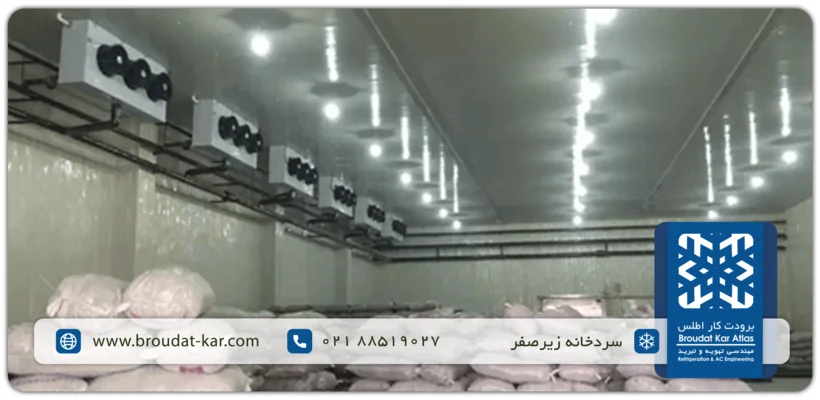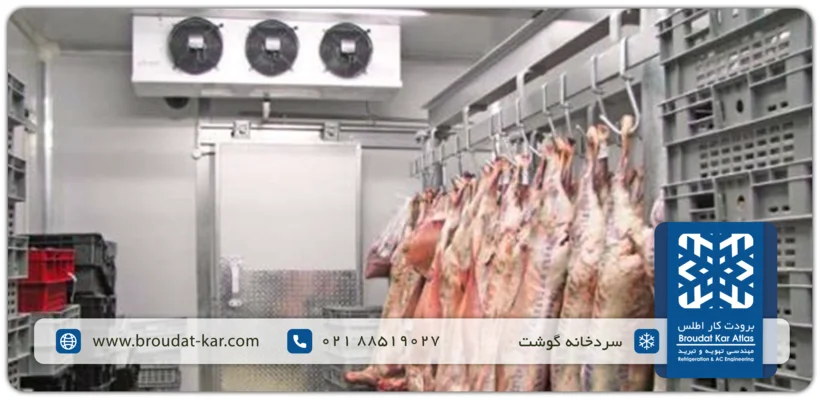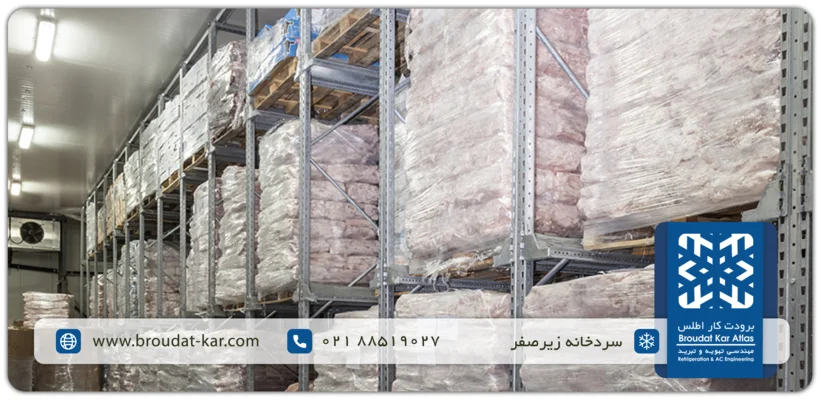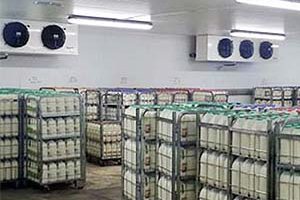What is a freezing cold room?
A freezing cold room is a specially insulated space designed to maintain temperatures between -10 and -35 degrees Celsius (-14 and -31 degrees Fahrenheit). It is primarily used for storing products that require subzero temperatures for preservation, such as various types of meat, fish, dairy products, frozen vegetables, ice cream, and certain medications and vaccines.
The freezing process slows down microbial activity and enzymatic reactions in the stored items, thereby extending their shelf life. By reducing the amount of liquid water through freezing, it also inhibits the growth of harmful microorganisms. Freezing cold rooms are crucial in the food and pharmaceutical industries for long-term storage of perishable goods, ensuring their quality and safety until they are ready for use or distribution.
Sub-Zero Cold Storage: Applications and Significance
Subzero cold rooms, typically operating at temperatures of -18 degrees Celsius and below, serve indispensable roles across various industries, significantly extending the shelf life and preserving the quality of perishable goods, particularly meat products.
One primary application of sub-zero cold rooms lies in the storage of frozen foods. This encompasses a diverse range of items, including frozen fruits, vegetables, meats, seafood, and prepared foods. By maintaining sub-zero temperatures, this storage method effectively halts microbial growth and enzymatic activities, thereby preventing food spoilage and ensuring food safety over extended periods.
In the pharmaceutical sector, sub-zero industrial refrigeration plays a crucial role in maintaining the stability of certain drugs, vaccines, and biologicals. These temperature-controlled environments are essential for preserving the strength and efficacy of sensitive pharmaceuticals, facilitating their distribution and use without compromising their quality or effectiveness.
Moreover, research and development laboratories heavily rely on subzero cold storage for the preservation of biological samples, tissues, and research specimens. The extreme cold conditions prevent degradation, enabling the long-term viability of these samples. This capability is paramount for ongoing medical experiments, studies, and advancements, ensuring the integrity and reliability of research outcomes.
Products Suitable for Sub-Zero Cold Storage
A wide range of products, from meat and poultry to ice cream and pharmaceuticals, require storage in a sub-zero cold room to maintain their quality and integrity. Here are some key items that benefit from sub-zero storage:
- Meat and Poultry: Beef, lamb, pork, and poultry products require sub-zero storage to prevent bacterial growth and maintain freshness.
- Seafood: Fish, shrimp, and other seafood items retain their quality and flavor when stored at sub-zero temperatures, preventing spoilage.
- Ice Cream and Frozen Desserts: Ice cream, sorbet, and other frozen desserts maintain their creamy texture and flavor profile when stored in a sub-zero environment.
- Dairy Products: Certain dairy items such as butter, cream, and specialty cheeses require sub-zero storage to prevent rancidity and maintain freshness.
- Prepared Foods: Frozen meals, pre-packaged entrees, and other prepared foods maintain their taste and texture when stored at sub-zero temperatures.
- Pharmaceuticals and Vaccines: Temperature-sensitive medications, vaccines, and biological products rely on sub-zero storage to maintain potency and effectiveness.
- Chemicals and Specialized Medications: Some chemicals and specialized medications may require sub-zero storage to prevent degradation and ensure stability.
Storing these products in a sub-zero cold room helps preserve their quality, extend their shelf life, and comply with regulatory standards for safety and efficacy.
Types of Sub-Zero Cold Storage
Dates Freezing Cold Room
Dates freezing cold rooms are specifically designed to store dates at temperatures below zero degrees Celsius (-18°C or 0°F). While dates can be stored for short periods at above-zero temperatures or even at room temperature, long-term storage necessitates sub-zero conditions to maintain quality and prevent spoilage. By preserving moisture and preventing deterioration, these freezing cold rooms ensure that dates retain their freshness and flavor over extended periods.
Frozen Fruit Subzero Freezer
Frozen fruits such as berries, cherries, apricots, peaches, mangoes, pineapples, and others require storage in a subzero cold room at temperatures around -18 degrees Celsius (-0.4 degrees Fahrenheit). Maintaining this temperature ensures the preservation of their freshness and prevents spoilage. For further details on this, please refer to the Fruit Cold Room page.
Subzero Cold Storage for Meat and Chicken
All types of meat, including beef, pork, lamb, and chicken, as well as fish and shrimp, should be stored at temperatures of -18 degrees Celsius (-0.4 degrees Fahrenheit) or lower. Maintaining this temperature range effectively preserves the quality, texture, and taste of these products, allowing for long-term storage.
Subzero Freezer for Seafood
Seafood like fish, shrimp, lobster, and squid should be stored at -18°C (0.4°F) in subzero cold storage to maintain freshness and quality, preventing spoilage.
Subzero Cold Storage for Pharmaceuticals and Vaccines
Certain drugs, vaccines, and biologicals necessitate extremely low temperatures for stability. For instance, Pfizer-BioNTech’s COVID-19 vaccine demands storage below -70°C (-94°F) to preserve its efficacy. Subzero cold storage is essential for maintaining these temperature-sensitive medical products.
Subzero Storage for Prepared Foods
Ready meals, frozen dinners, and pre-prepared foods are best stored in subzero freezers at -18°C (-0.4°F). This temperature ensures long-lasting preservation of taste, texture, and quality.
Subzero Freezing for Frozen Vegetables
Frozen vegetables like peas, corn, broccoli, spinach, and carrots maintain optimal quality when stored in a subzero freezer at -18°C (-0.4°F), ensuring long-term freshness and preserving their nutritional value.
Subzero Cold Storage for Dairy Products
To preserve their creamy texture and prevent ice crystal formation, dairy items like ice cream, butter, gelato, and dairy desserts are best stored between -20°C and -25°C (-4°F and -13°F) in subzero cold storage facilities.
Subzero Cold Storage for Cooked Products
Certain baked items like pastry dough, pies, and select bread types can be stored in subzero freezers, with optimal temperatures varying. Generally, -18°C (-0.4°F) is suitable for preserving freshness.
Subzero Cold Storage Equipment
Constructing a subzero cold room requires refrigeration and auxiliary equipment. Main components include compressors, heat exchangers, electrical panels, insulation panels, cold room doors, and more.
Subzero Cold Room Compressor
The compressor, a pivotal component in the refrigeration cycle, comes in various types: hermetic, semi-hermetic, and open-type. Selection depends on factors like cold store capacity and electricity supply. Achieving temperatures below -25°C may require two-stage compressors or liquid injection systems.
Subzero Cold Storage Condenser and Evaporator
Condensers and evaporators are vital heat exchangers in cold rooms. The evaporator absorbs heat from products and the cold room, while the condenser dissipates this heat to the environment. Design and selection depend on factors like product type, capacity, refrigerant, and defrost method. Industrial cold rooms often feature custom-designed condensers and evaporators, while standard sizes are common in smaller setups. Heat exchangers come in various types including Air-Cooled and Water Cooled like shell and tube, and plate types.
Subzero Cold Room Electrical Panel
The electrical panel in a subzero cold room distributes power to components like compressors and fans. Each consumer has a dedicated switch to prevent overloading. Additionally, the panel controls equipment operation for optimal functionality.
Subzero Cold Room Panel and Door
Subzero cold storage construction typically utilizes injected polyurethane sandwich panels, 15 cm thick with a density of 40 kg/m3. The cold room door, also made of polyurethane with similar specifications, is available in hinged and sliding configurations.
Peripheral Equipment of Subzero Cold Storage
Humidifier or Dehumidifier
For products sensitive to humidity, dehumidifiers maintain optimal humidity levels, crucial for subzero storage.
Pallet or Forklift Truck
Efficient cargo handling relies on appropriate machinery. Pallet trucks or forklifts aid in loading and unloading pallets or containers.
Shelving or Box Pallets
Shelving systems optimize storage space and organization. Box pallets are commonly used, while more advanced shelving options are available.
Monitoring System
Continuous temperature monitoring via sensors ensures prompt action if deviations occur, safeguarding product quality.
Cold Room Lighting
Adequate lighting prevents accidents during loading and unloading. LED or low-power lamps are preferred for their low heat generation.
Pricing for Subzero Freezers
Determining the cost of a sub-zero freezer involves factors like size, capacity, refrigerant type, system components, insulation, and door type. Steps for pricing include assessing customer needs, estimating insulation and door dimensions, selecting compressor and evaporator, designing control devices, and calculating assembly costs. Atlas Refrigeration Company provides rough annual estimates for small to medium-sized cold storage units. However, due to technical complexities, industrial cold storage and ammonia cold storage require project-specific evaluation for accurate pricing. Contact us for tailored pricing.
Sub-Zero Cold Storage Construction Services by Atlas Refrigeration Company
Atlas Refrigeration Company offers comprehensive services for sub-zero cold storage construction. With over 30 years of experience, we tailor solutions to fit your needs and budget. Our services include design, construction, implementation, operation training, and after-sales support for turnkey projects. Trust us for top-notch sub-zero cold storage solutions.
Closing Thoughts on Sub-Zero Freezers
Sub-zero cold rooms play a vital role in modern industries and meeting our contemporary needs. This article outlined sub-zero cold storage equipment and its importance in preserving various products, from perishable foods to temperature-sensitive medicines. We discussed factors influencing pricing and reiterated our commitment to delivering high-quality solutions at competitive rates. At Atlas Refrigeration, we strive to offer advanced subzero refrigeration solutions while ensuring cost-effectiveness.
Related posts
Sub-Zero Cold Storage
What is Fruit Cold Storage? A Fruit coldroom is a specialized facility designed to store fruits and vegetables in
What is dairy cold storage? Dairy cold storage stands as a pivotal element within the dairy industry, crucial for the
What Is Chicken Cold Storage? Chicken cold storage refers to specialized equipment designed for preserving poultry products like chicken
Fish and Shrimp Cold Storage Systems – Preserving Freshness Fish and shrimp cold storage facilities play an important role in
Portable Cold Store; Design and Construction of Portable Cold Store + Price The portable cold room, also known as
What is Industrial Cold store? An industrial cold store is a large-scale facility designed and constructed to preserve and












